Many people dream about visiting the Taj Mahal, in India. No wonder! The place is huge, incredible, beautiful, and ‘full of history’. Located in Agra, 131 miles (212 km) from New Delhi, it’s is one of the main day trips you can make from the Indian capital.
But visiting any destination in India is not for the faint of heart. The country’s inequalities, aggressive poverty, chaotic traffic, and disconcerting noise can shock first-time visitors. Every time I came back from there, I was sure it would be the last. However, a few days later, I get myself planning my next trip to India. It’s impossible not to recognize the joy of its people, the beauty of its monuments, its culture, history, and delicious cuisine.
In this article, I am going to talk about India’s main attraction: the Taj Mahal. Check it out!
Taj Mahal: a brief history

Taj Mahal is a sumptuous mausoleum nominated a UNESCO World Heritage Site. The site is considered one of the 7 wonders of the modern world.
It was built by Emperor Shah Jahan for his beloved wife Mumtaz Mahal. By the way, her name means “the jewel of the palace”. She married the emperor at the age of 19 and soon became his favorite wife as well as his main advisor. Together they had 14 children, however, during the delivery of the last baby, she died at the age of 39 (1631).
On her deathbed, she made 3 requests to Shah Jahan: not to remarry; to dedicate himself to raising children, and to build a monument that represented the love between them.
Due to his wife’s death, Shah Jahan mourned his empire for 2 years, banning music and other celebrations. In 1632, he started building a huge and fabulous mausoleum to honor the memory of his beloved wife. It was the Taj Mahal.
More than 20,000 people worked on the construction of the Taj Mahal complex which lasted 22 years. According to legend, the workers were blinded and had their hands cut off at the end so they wouldn’t build anything like that.
Shortly after the Taj Mahal was completed, Shan Jahan’s health deteriorated and the struggle for the throne’s succession intensified. In 1658, he was deposed by his son Aurangzeb who arrested him at Agra Fort. Shan Jahan is said to have spent the rest of his days enjoying the Taj Mahal from a small window in his cell. In 1666, the year of his death, he was buried alongside his beloved.

The entire Taj Mahal complex is symmetrical. Shan Jahan’s grave is an exception. His original idea was to build a black Taj Mahal (made of black onyx) for his grave on the other side of the Yamuna River. However, the project never left the drawing paper and, as a result, his body was buried next to his wife, asymmetrically.
About Taj Mahal complex

The Taj Mahal complex covers an area of 17,000 m2 and consists of three main buildings: the mausoleum and two identical buildings (one on each side), four minarets, and gigantic gardens that intended to recreate Paradise.
By the way, the 41-meter minarets were built with a slight outward slope (2.5°) so as not to hit the palace in case there was an earthquake.
The two buildings next to the mausoleum are a mosque (on the right – facing Mecca) and a “guest house” on the left. According to what we were told, the mosque was built so that workers, mostly Muslims, did not have to walk 2.5 km to pray five times a day. That would delay the work. The guest house was built to keep the symmetry.
To get to the complex, you can walk or take a bus from the parking lot to the East Gate, where you get into the complex. Walking a few meters, you get to a Courtyard (Jilaukhana).
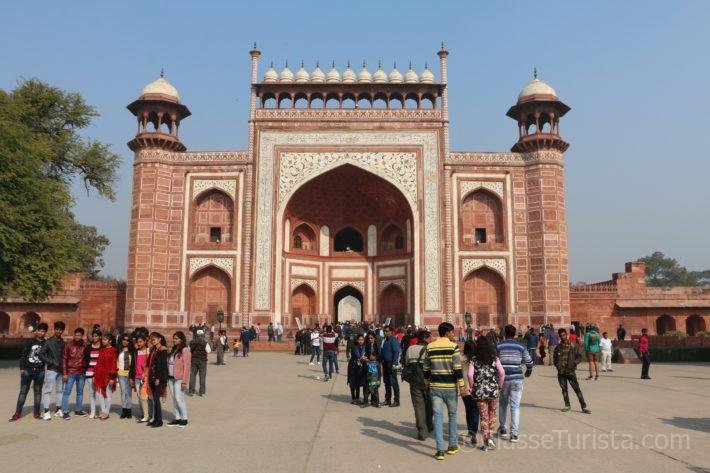
Looking northwards, you’ll see the Royal Entrance (Great Gate), with a beautiful red stone building (Darwaza), richly decorated. Its central door works as a natural frame for the mausoleum. I was enchanted by my first view of the mausoleum.

Walking through the door, you can see a symmetrical garden, made up of trees, flower beds, and elevated paths, which is an invitation to contemplation. Right in the center, the famous water mirror that yields the best photos of the visit (cover photo). It’s simply unspeakable to capture the image of the Taj Mahal reflected in the water.

The complex also had other constructions that don’t deserve too much attention, such as, the tombs in memory of Shan Jahan’s two other wives and the tomb that they believe to be the main chaperone of Mumtaz Mahal.
On the architecture of Taj Mahal
Taj Mahal is a perfect fusion of Indian and Persian architecture. The mausoleum was built with white marble decorated with various precious and semi-precious stones such as lapis lazuli from Afghanistan, jades from China, and amethysts from Persia. The stones were delicately embedded in the marble.
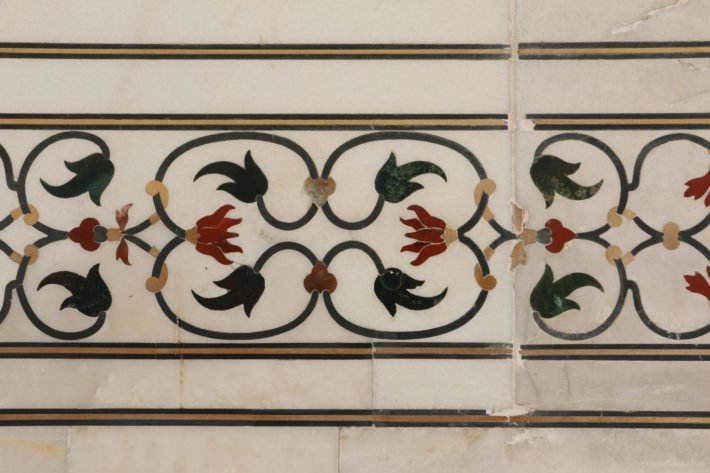
The work is so perfect, it will leave you intrigued. There are colorful flowers and plants, geometric figures, and writings from the Koran, which decorate the walls of the palace.
I’m sure you won’t miss the main dome of the mausoleum. Quite common in Islamic architecture, it is all decorated with gold threads and carved Lotus flowers. Its spire was originally made of gold, but after plunder, it was replaced by a bronze one.
- By the way, the walls of the Taj Mahal seem to change color during the day. Depending on the lighting, they can acquire a pink or golden color.
Inside the Mausoleum
The interior of the mausoleum is richly decorated. Pay attention to the walls! In the central hall are the two cenotaphs. They are quite simple as required by the Muslim tradition. However, the remains are not there, but in the basement of the palace, which is not open to the public. Unfortunately, taking pictures inside the mausoleum is not allowed!
How to visit the Taj Mahal?
To visit the Taj Mahal, you can take a day trip to Agra from New Delhi, as we did.
Leaving New Delhi, the 210 km journey can be done by car (3 hours) or by train. We opted for the high-speed train (Gatimaan Express) and it was very comfortable (read below).
Some people choose to stay overnight in Agra. I don’t think it’s worth it, because the city doesn’t have many other attractions. The great pro of staying in Agra is being able to visit the temple at sunrise (when it is much emptier) or at sunset, which yields beautiful photos.
The complex is open to visitors every day, except on Fridays. Visitation starts 30 min before sunrise and ends 30 min before sunset.
Tickets can be purchased at the box office or through the official websites (Payumoney & Asiagracircle). If you are coming on an excursion, confirm beforehand if your ticket is already included in the tour package.
The ticket price for tourists is 1,300 rupees (about 17 USD). Children under 15 don’t have to pay.
Food or drones are not allowed. Remember to dress respectfully!
Other attractions in and around Agra
Besides Taj Mahal, Agra and its surroundings have other attractions for tourists. During our tour, we visited only the first two of the following attractions.
Agra Fort

It is a walled palace-city, built on the banks of the Yamuna River between 1565 and 1573 by Emperor Akbar. The Fort, built entirely of red stone and white marble, occupies a vast area. It contains 3 mosques (one of them for women in the Emperor’s Harem), two palaces with beautiful walls with various carved details, and a space for a public audience among other attractions.
It was at the Red Fort that Shah Jahan was imprisoned and spent his last days enjoying the Taj Mahal in the distance.
Agra Fort is also a nice place to take incredible pictures.
Itmad-ud-Daulah

Nicknamed Mini Taj, Itimad-ud-daulah is a building commissioned by Empress Noor Jahan in memory of his father Mirza Ghiyas Beg. It is the first construction in the Mughal style before the Taj Mahal. The construction began in 1622 and was completed in 1628. Also built-in white marble and with an attached garden, it has several details that served as inspiration for the Taj Mahal.
Its entrance gate is also beautiful. Built-in red stone and decorated with flowers and geometric motifs of inlaid withe marble, it is worth a visit. The mausoleum is richly adorned! When you get close you will be delighted with the delicacy of the details.
Sikandara
Located 7 km from the city of Agra, it is the mausoleum of Emperor Akbar the Great.
Fatehpur Sikri
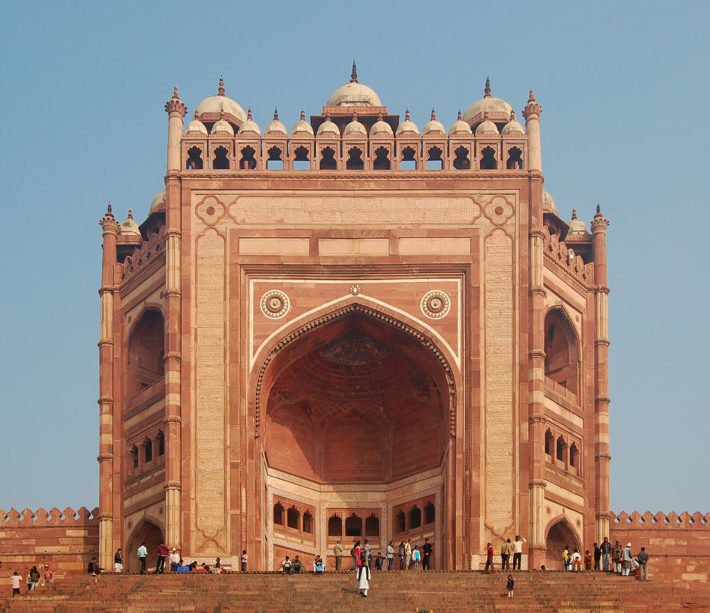
Located 40 km from Agra, it was built in the late 15th century by Emperor Akbar to be a support site for the capital of the Mughal Empire. It was mysteriously abandoned after 14 years. It is unknown whether this was due to a lack of water at the site or due to geopolitical issues. The city remains very well preserved after almost 500 years of existence.
The highlight of the building is the tomb of Sheik Salin, at the Jama Masjid Mosque, where many believers go in search of miracles. According to Legend, Sheik Salin had a vision of the birth of the son so dreamed of by the Emperor and the mosque was built in his honor. To try your luck, tie a ribbon to a canvas, cover the tomb with a beautiful fabric, and throw rose petals over it. Everything is sold by street vendors on site. I was sad not to have visited. Maybe next time!
How was our trip to Agra?

We took an organized tour from New Delhi. The operator was Travel Creators of India. The tour included hotel pick-up and a guide accompanying us to our train car (he only left when we got on the train). Both on the way and on the way back.
The train was the Gatimaan Express, the fastest train in India, which reaches 160 km/h (99 mph). We left at 8:10 am and arrived in Agra at 9:50 am. Breakfast, on the way, and dinner, on the way back, were also included in the package.

When we arrived in Agra, our driver and guide were waiting for us at the station platform. We arrived early at the Taj Mahal. Then we visit Fort Agra and Itmad-Ud-Daulah. All tickets were also included in the package, which meant that we avoided the queue to buy, but not to enter the attractions.
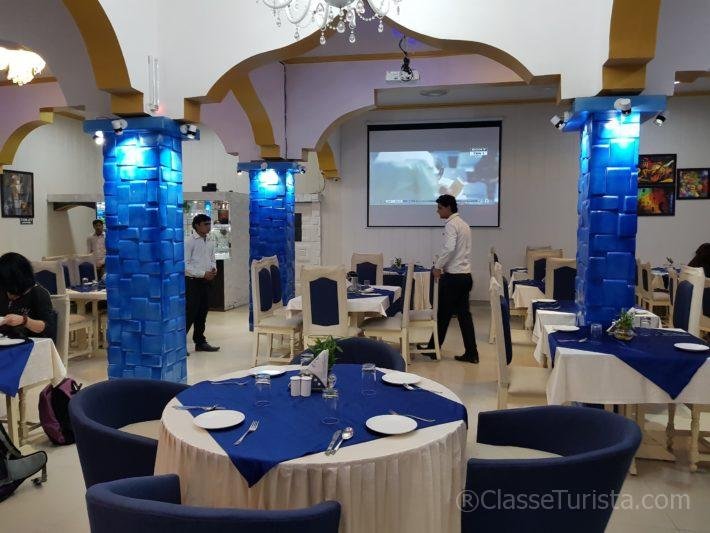
We had lunch at The MasterChef Restaurant, a very nice multi-cuisine restaurant (Indian, Italian, Chinese, continental) in Agra. As you can see in the picture, the restaurant is all decorated in blue. The food was good and the price was reasonable. The service was excellent.
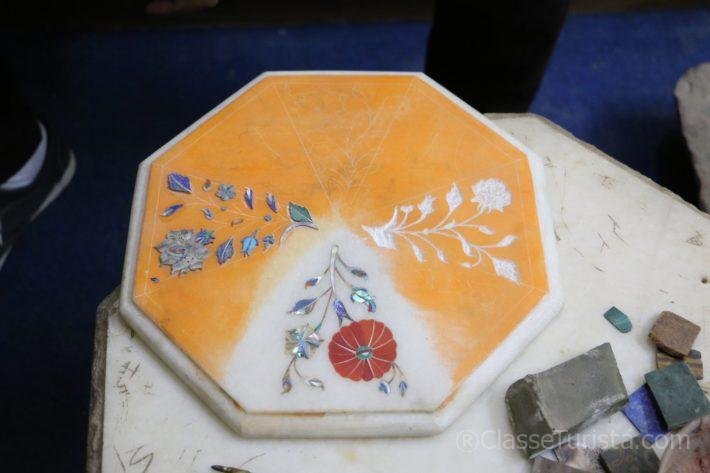
Then, we went to King Craft Palace craft store, where we could observe, in various objects, the technique used in the Taj Mahal to inlay stones in marble. There were plates, glasses, cup holders, buddhas, wine glasses, boxes, among others, all made of marble and decorated. They are different designs. One more beautiful than the other. Prices, however, are quite expensive and quoted in US dollars.

After visiting the store at 3 pm, we were ready to return to New Delhi. However, our train left only in the early evening. There was time for a coffee before returning to the station.
We arrived in New Delhi around 7:30 pm, and our driver was there on the platform waiting for us to take us to the hotel. Excellent service!
We paid US$ 120 per person at the time, but I think it was worth it. Visiting Agra as a day trip was tiring, but, as I said, I don’t think it’s worth sleeping there. I also thought it was important to have a guide, not only for the information provided but for making the whole tour more relaxing.
Bottom line
During the tour, you will spend a lot of time trying to take the perfect photo of the Mausoleum reflected in the water mirror, so I suggest that it be the first thing you do. Try to get early in the complex, so to avoid that crowd in your dream photo.
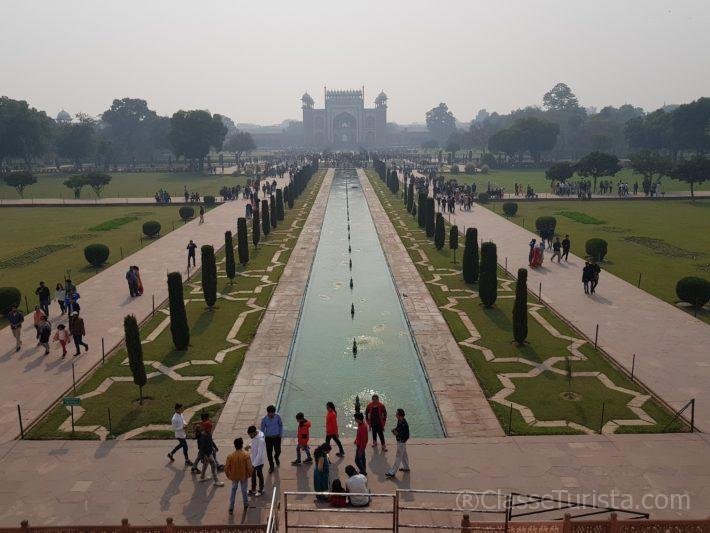
Stroll peacefully through the gardens, enjoying the local atmosphere. Take your time. After seeing this architectural perfection, the other sights are not so interesting, except the Agra Fort, where you will once again try to take a picture of the Taj Mahal.
During all our tours in India, children, men, and women asked me to take pictures with me! I was really happy to say “yes” to them. That was one of those special photos!
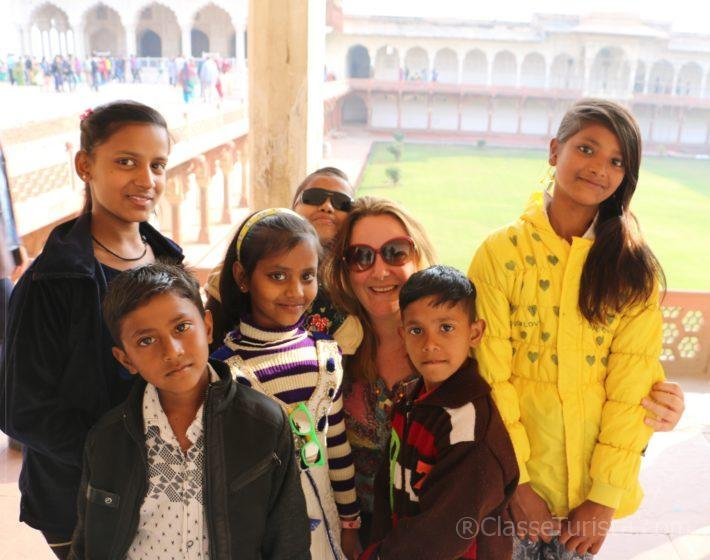
Visiting the Taj Mahal is an unspeakable experience. Yes, it is beautiful, imposing, and exciting. It is certainly an incredible destination!
- Hope you enjoy this article. Check out all our English Posts!



